check engine CHRYSLER PT CRUISER 2005 1.G Owner's Manual
[x] Cancel search | Manufacturer: CHRYSLER, Model Year: 2005, Model line: PT CRUISER, Model: CHRYSLER PT CRUISER 2005 1.GPages: 360, PDF Size: 11.21 MB
Page 272 of 360
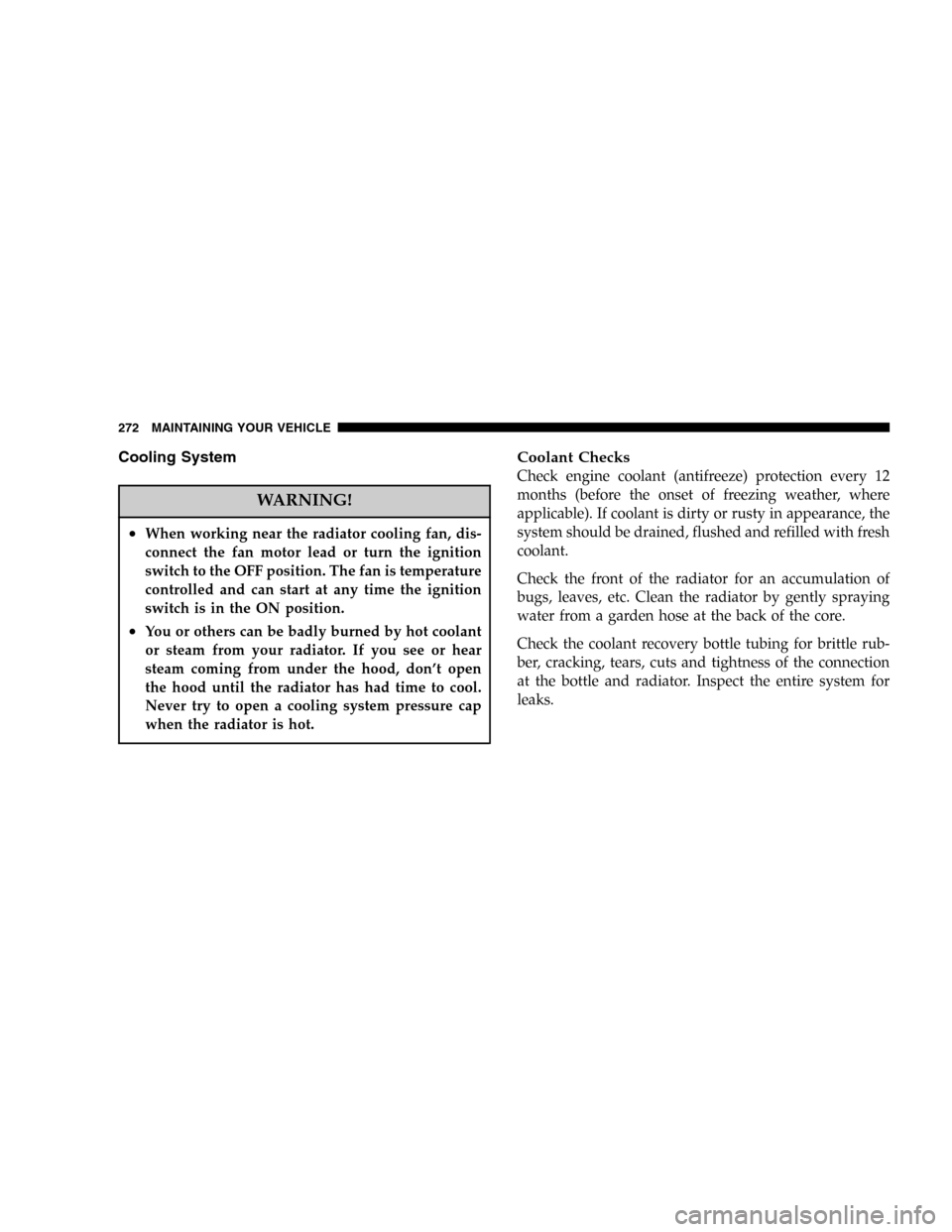
Cooling System
WARNING!
•When working near the radiator cooling fan, dis-
connect the fan motor lead or turn the ignition
switch to the OFF position. The fan is temperature
controlled and can start at any time the ignition
switch is in the ON position.
•You or others can be badly burned by hot coolant
or steam from your radiator. If you see or hear
steam coming from under the hood, don’t open
the hood until the radiator has had time to cool.
Never try to open a cooling system pressure cap
when the radiator is hot.
Coolant Checks
Check engine coolant (antifreeze) protection every 12
months (before the onset of freezing weather, where
applicable). If coolant is dirty or rusty in appearance, the
system should be drained, flushed and refilled with fresh
coolant.
Check the front of the radiator for an accumulation of
bugs, leaves, etc. Clean the radiator by gently spraying
water from a garden hose at the back of the core.
Check the coolant recovery bottle tubing for brittle rub-
ber, cracking, tears, cuts and tightness of the connection
at the bottle and radiator. Inspect the entire system for
leaks.
272 MAINTAINING YOUR VEHICLE
Page 273 of 360

With the engine at normal operating temperature (but
not running), check the cooling system pressure cap for
proper vacuum sealing by draining a small amount of
coolant from the radiator drain cock. If the cap is sealing
properly, the engine coolant (antifreeze) will begin to
drain from the coolant recovery bottle. DO NOT RE-
MOVE THE COOLANT PRESSURE CAP WHEN THE
COOLING SYSTEM IS HOT.
Cooling System—Drain, Flush and Refill
At the intervals shown on the Maintenance Schedules,
the system should be drained, flushed and refilled.
If the solution is dirty and contains a considerable
amount of sediment, clean and flush with a reliable
cooling system cleaner. Follow with a thorough rinsing to
remove all deposits and chemicals. Discard oil antifreeze
solution.
Selection Of Coolant
Use only the manufacturers recommended coolant, refer
to Recommended Fluids, Lubricants and Genuine Parts
for correct coolant type.
MAINTAINING YOUR VEHICLE 273
7
Page 275 of 360
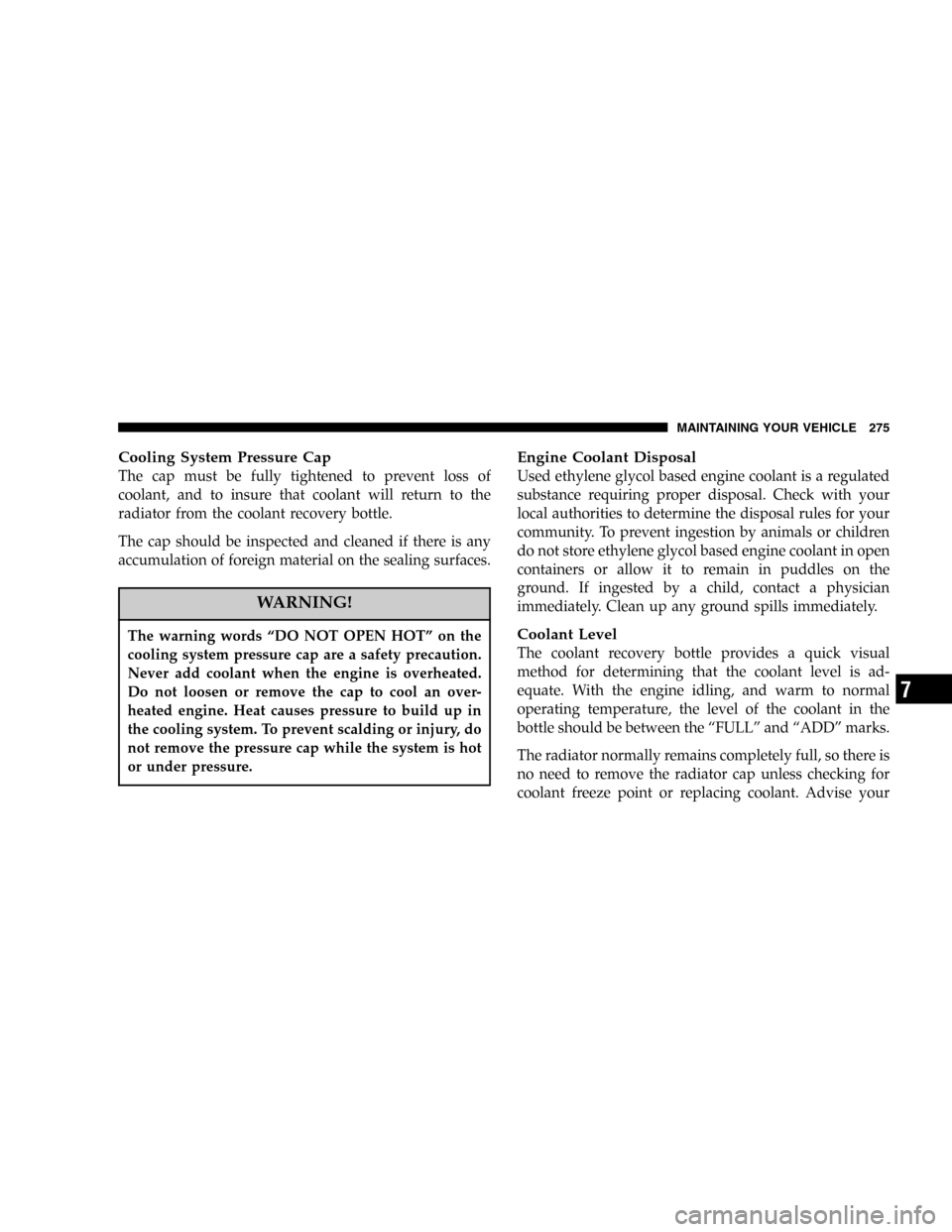
Cooling System Pressure Cap
The cap must be fully tightened to prevent loss of
coolant, and to insure that coolant will return to the
radiator from the coolant recovery bottle.
The cap should be inspected and cleaned if there is any
accumulation of foreign material on the sealing surfaces.
WARNING!
The warning words“DO NOT OPEN HOT”on the
cooling system pressure cap are a safety precaution.
Never add coolant when the engine is overheated.
Do not loosen or remove the cap to cool an over-
heated engine. Heat causes pressure to build up in
the cooling system. To prevent scalding or injury, do
not remove the pressure cap while the system is hot
or under pressure.
Engine Coolant Disposal
Used ethylene glycol based engine coolant is a regulated
substance requiring proper disposal. Check with your
local authorities to determine the disposal rules for your
community. To prevent ingestion by animals or children
do not store ethylene glycol based engine coolant in open
containers or allow it to remain in puddles on the
ground. If ingested by a child, contact a physician
immediately. Clean up any ground spills immediately.
Coolant Level
The coolant recovery bottle provides a quick visual
method for determining that the coolant level is ad-
equate. With the engine idling, and warm to normal
operating temperature, the level of the coolant in the
bottle should be between the“FULL”and“ADD”marks.
The radiator normally remains completely full, so there is
no need to remove the radiator cap unless checking for
coolant freeze point or replacing coolant. Advise your
MAINTAINING YOUR VEHICLE 275
7
Page 276 of 360

service attendant of this. As long as the engine operating
temperature is satisfactory, the coolant recovery bottle
need only be checked once a month.
When additional coolant is needed to maintain the
proper level, it should be added to the coolant recovery
bottle. Do not overfill.
Points To Remember
NOTE:When the vehicle is stopped after a few kilome-
ters (a few miles) of operation, you may observe vapor
coming from the front of the engine compartment. This is
normally a result of moisture from rain, snow, or high
humidity accumulation on the radiator and being vapor-
ized when the thermostat opens, allowing hot water to
enter the radiator.
If an examination of your engine compartment shows no
evidence of radiator or hose leaks, the vehicle may be
safely driven. The vapor will soon dissipate.
•Do not overfill the coolant recovery bottle.
•Check coolant freeze point in the system.
•If frequent coolant additions are required, the cooling
system should be pressure tested for leaks.
•Maintain coolant concentration at 50% HOAT ethylene
glycol engine coolant (minimum) and distilled water
for proper corrosion protection of your engine which
contains aluminum components.
•Make sure that the radiator and coolant recovery
bottle hoses are not kinked or obstructed.
•Keep the front of the radiator clean. If your vehicle has
air conditioning, keep the front of the condenser clean,
also.
276 MAINTAINING YOUR VEHICLE
Page 279 of 360

NOTE:Inspection of brake hoses should be done when-
ever the brake system is serviced and at every engine oil
change.
WARNING!
Worn brake hoses can burst and cause brake failure.
You could have an accident. If you see any signs of
cracking, scuffing, or worn spots, have the brake
hoses replaced immediately.
Brake Master Cylinder
The fluid level in the master cylinder should be checked
when performing under hood services, or immediately if
the brake system warning lamp is on.
Be sure to clean the top of the master cylinder area before
removing the cap. If necessary, add fluid to bring the
fluid level up to the requirements described on the brakefluid reservoir. Fluid level can be expected to fall as the
brake pads wear. Brake fluid level should be checked
when pads are replaced. However, low fluid level may be
caused by a leak and a checkup may be needed.
Brake Fluid Master Cyclinder
MAINTAINING YOUR VEHICLE 279
7
Page 281 of 360
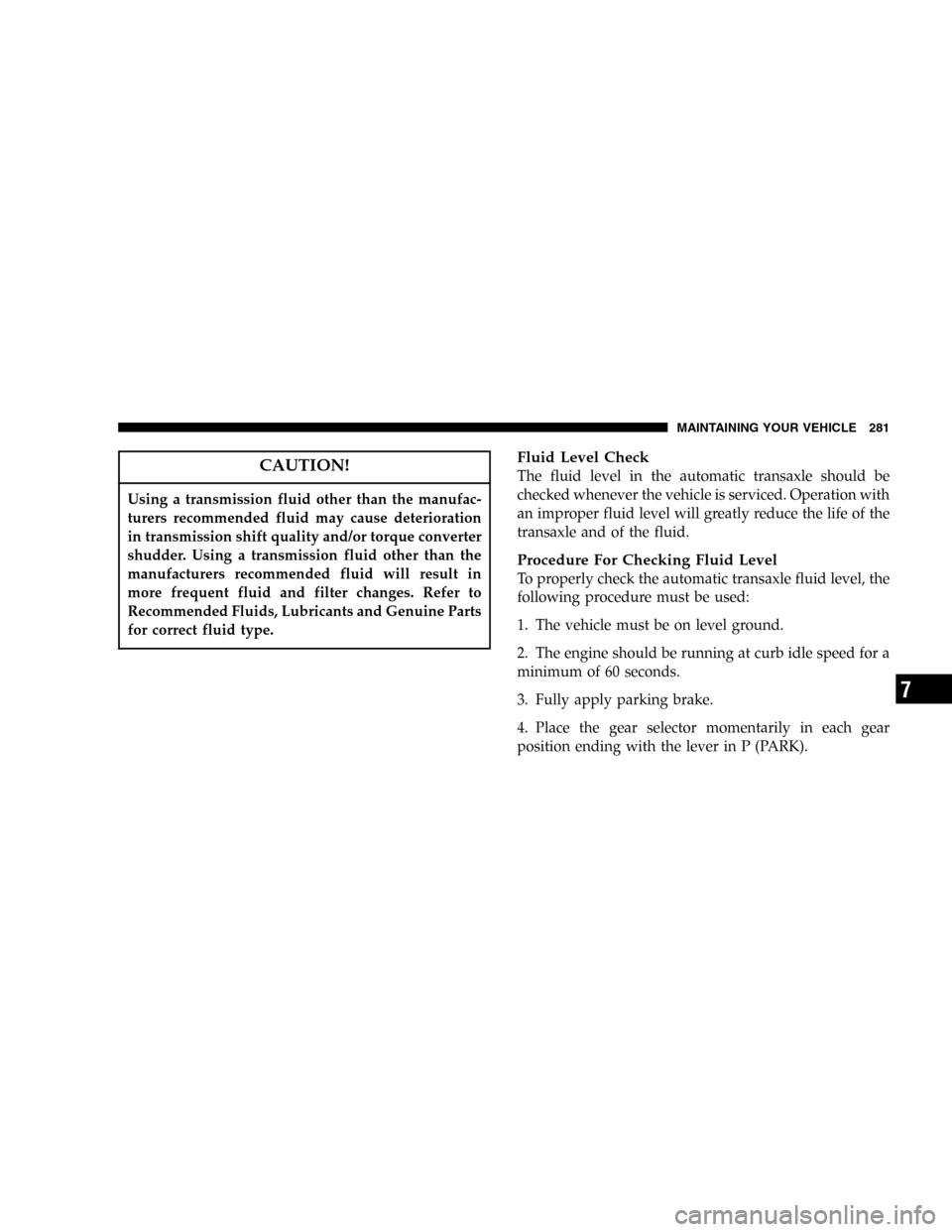
CAUTION!
Using a transmission fluid other than the manufac-
turers recommended fluid may cause deterioration
in transmission shift quality and/or torque converter
shudder. Using a transmission fluid other than the
manufacturers recommended fluid will result in
more frequent fluid and filter changes. Refer to
Recommended Fluids, Lubricants and Genuine Parts
for correct fluid type.
Fluid Level Check
The fluid level in the automatic transaxle should be
checked whenever the vehicle is serviced. Operation with
an improper fluid level will greatly reduce the life of the
transaxle and of the fluid.
Procedure For Checking Fluid Level
To properly check the automatic transaxle fluid level, the
following procedure must be used:
1. The vehicle must be on level ground.
2. The engine should be running at curb idle speed for a
minimum of 60 seconds.
3. Fully apply parking brake.
4. Place the gear selector momentarily in each gear
position ending with the lever in P (PARK).
MAINTAINING YOUR VEHICLE 281
7
Page 283 of 360
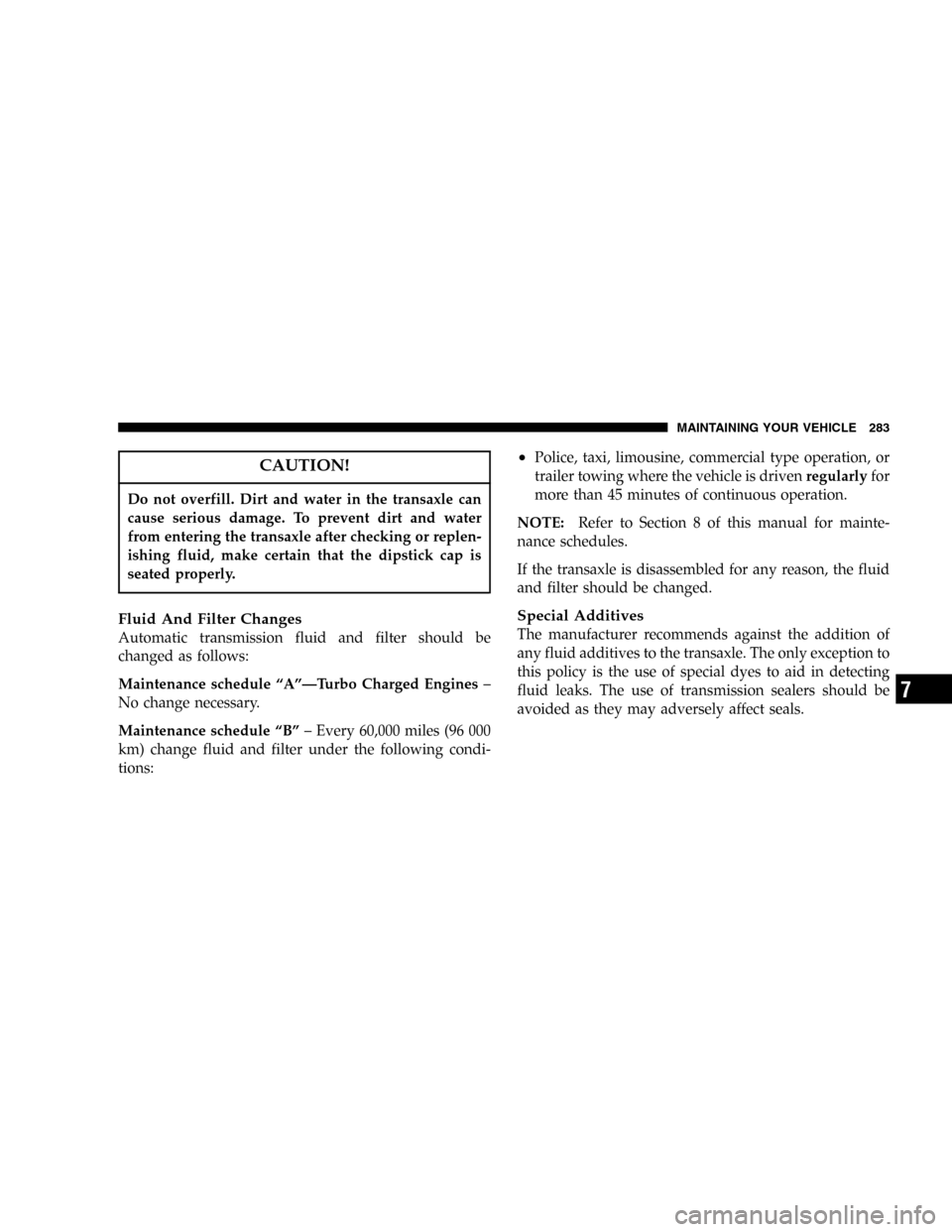
CAUTION!
Do not overfill. Dirt and water in the transaxle can
cause serious damage. To prevent dirt and water
from entering the transaxle after checking or replen-
ishing fluid, make certain that the dipstick cap is
seated properly.
Fluid And Filter Changes
Automatic transmission fluid and filter should be
changed as follows:
Maintenance schedule“A”—Turbo Charged Engines–
No change necessary.
Maintenance schedule“B”–Every 60,000 miles (96 000
km) change fluid and filter under the following condi-
tions:
•Police, taxi, limousine, commercial type operation, or
trailer towing where the vehicle is drivenregularlyfor
more than 45 minutes of continuous operation.
NOTE:Refer to Section 8 of this manual for mainte-
nance schedules.
If the transaxle is disassembled for any reason, the fluid
and filter should be changed.
Special Additives
The manufacturer recommends against the addition of
any fluid additives to the transaxle. The only exception to
this policy is the use of special dyes to aid in detecting
fluid leaks. The use of transmission sealers should be
avoided as they may adversely affect seals.
MAINTAINING YOUR VEHICLE 283
7
Page 308 of 360
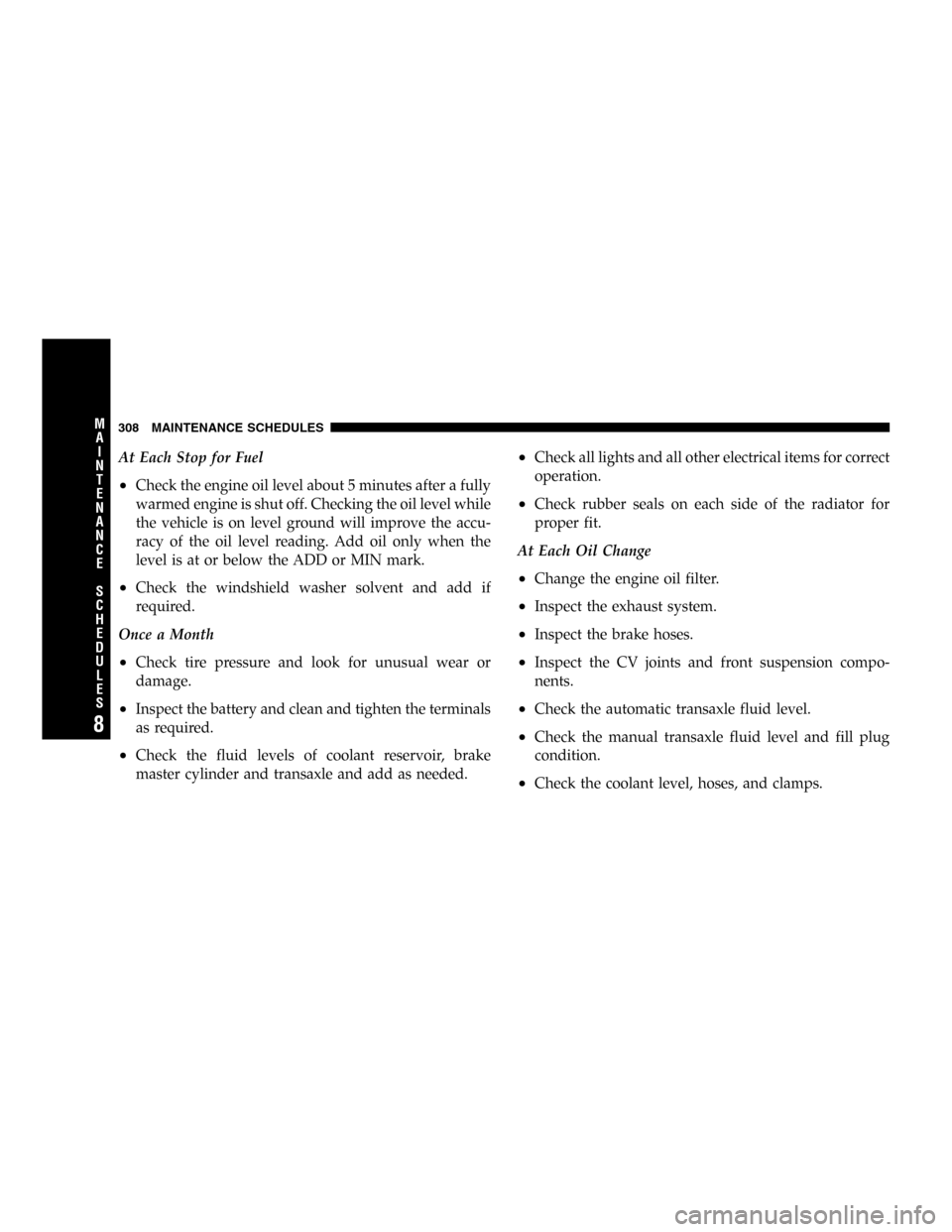
At Each Stop for Fuel
•Check the engine oil level about 5 minutes after a fully
warmed engine is shut off. Checking the oil level while
the vehicle is on level ground will improve the accu-
racy of the oil level reading. Add oil only when the
level is at or below the ADD or MIN mark.
•Check the windshield washer solvent and add if
required.
Once a Month
•Check tire pressure and look for unusual wear or
damage.
•Inspect the battery and clean and tighten the terminals
as required.
•Check the fluid levels of coolant reservoir, brake
master cylinder and transaxle and add as needed.
•Check all lights and all other electrical items for correct
operation.
•Check rubber seals on each side of the radiator for
proper fit.
At Each Oil Change
•Change the engine oil filter.
•Inspect the exhaust system.
•Inspect the brake hoses.
•Inspect the CV joints and front suspension compo-
nents.
•Check the automatic transaxle fluid level.
•Check the manual transaxle fluid level and fill plug
condition.
•Check the coolant level, hoses, and clamps.
308 MAINTENANCE SCHEDULES
8
M
A
I
N
T
E
N
A
N
C
E
S
C
H
E
D
U
L
E
S
Page 340 of 360

ABS (Anti-Lock Brake) System.............. 198
Adding Engine Coolant (Antifreeze).......... 274
Adding Fuel........................... 225
Adding Washer Fluid..................... 100
Additives, Fuel......................... 223
Air Cleaner, Engine (Engine Air Cleaner Filter) . . . 264
Air Conditioner Maintenance............... 267
Air Conditioning Controls................. 169
Air Conditioning, Operating Tips............ 174
Air Conditioning Refrigerant.............267,268
Air Conditioning System................169,267
Air Pressure, Tires....................... 211
Airbag................................ 40
Airbag Deployment....................... 46
Airbag Light.....................44,48,58,132
Airbag Maintenance....................... 48
Airbag, Side............................ 46
Alarm, Panic............................ 22
Alarm System........................25,127Alignment and Balance................... 218
Alterations/Modifications, Vehicle............. 7
Antifreeze (Engine Coolant)...........273,302,303
Capacities........................... 302
Anti-Lock Brake System (ABS).............. 198
Anti-Lock Warning Light.................. 129
Anti-Theft Security Alarm.................. 25
Appearance Care........................ 284
Auto Down Power Windows................ 29
Automatic Door Locks..................... 20
Automatic Transaxle..............12,182,185,280
Fluid and Filter Changes................. 283
Fluid Level Check...................... 281
Interlock System.....................18,186
Reset Mode.......................... 187
Selection Of Lubricant................... 280
Shifting............................. 187
Special Additives...................... 283
Autostick...........................134,190
340 INDEX
Page 342 of 360

Cellular Phone.......................... 168
Center High Mounted Stop Light............ 301
Central Door Locks....................... 20
Chains, Tire............................ 219
Changing A Flat Tire..................... 235
Chart, Tire Sizing........................ 203
Check Engine Light (Malfunction Indicator Light) . 255
Child Restraint.......................... 49
Child Restraint Tether Anchors............... 53
Child Seat.............................. 54
Clean Air Gasoline....................... 222
Climate Control......................... 169
Clock................................ 134
Coin Holder........................... 115
Compact Disc Maintenance................. 168
Compact Disc Player..................136,142
Compact Spare Tire...................... 214
Compass.............................. 75
Compass Calibration...................... 78Compass Variance........................ 77
Console............................... 115
Contract, Service........................ 332
Convertible............................. 62
Convertible Boot.......................68,72
Convertible Top.......................... 62
Convertible Top Maintenance............... 290
Convertible Top Manual Override..........73,247
Cool Down, Turbo....................... 184
Coolant............................302,303
Coolant Pressure Cap..................... 275
Cooling System......................... 272
Adding Coolant (Antifreeze).............. 274
Coolant Level......................272,275
Disposal of Used Coolant................ 275
Drain, Flush, and Refill.................. 273
Inspection........................... 275
Points to Remember.................... 276
Pressure Cap......................... 275
342 INDEX